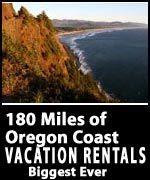Oregon Coast Study: Cape Kiwanda Sinkholes Breaking It Into 'Islands;' More Fencing Needed
Published 10/21/23 at 6:52 p.m.
By Oregon Coast Beach Connection staff
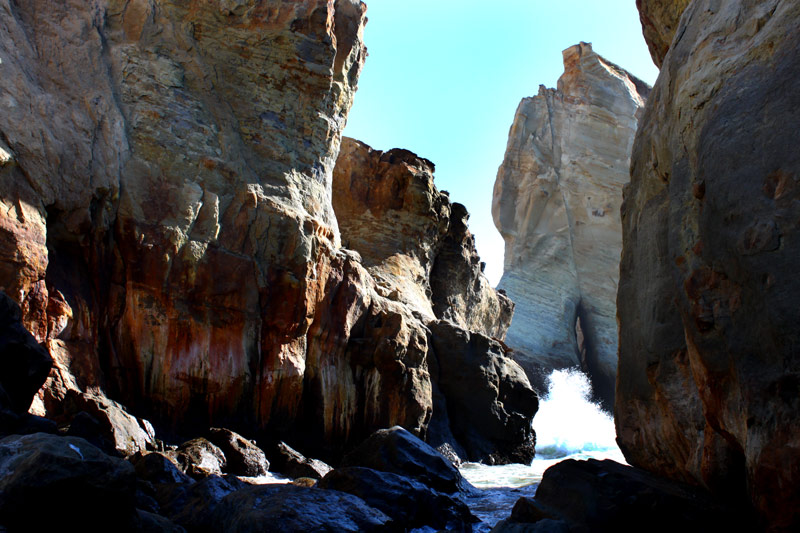
(Pacific City, Oregon) – Back in January of 2023, park rangers at Cape Kiwanda discovered there was a sizable sinkhole on one part of the headland. One of the Oregon coast's biggest attractions had a new danger, and then by the middle of the year a second sinkhole developed, becoming even more problematic. As Oregon Parks and Recreation Department (OPRD) kept up with the growing holes, new fencing was implemented each time the holes enlarged. (Photo Oregon Coast Beach Connection: Kiwanda is going to look more like this - even that arch is now gone)
Now, a study by the Oregon Department of Geology and Mineral Industries (DOGAMI) has figured out the cause, recommending fencing should be moved back even further as they predict a large chunk of the Oregon favorite will eventually collapse away. In fact, they believe this erosion will cut far back into Cape Kiwanda and create new sea stacks and other separated features.
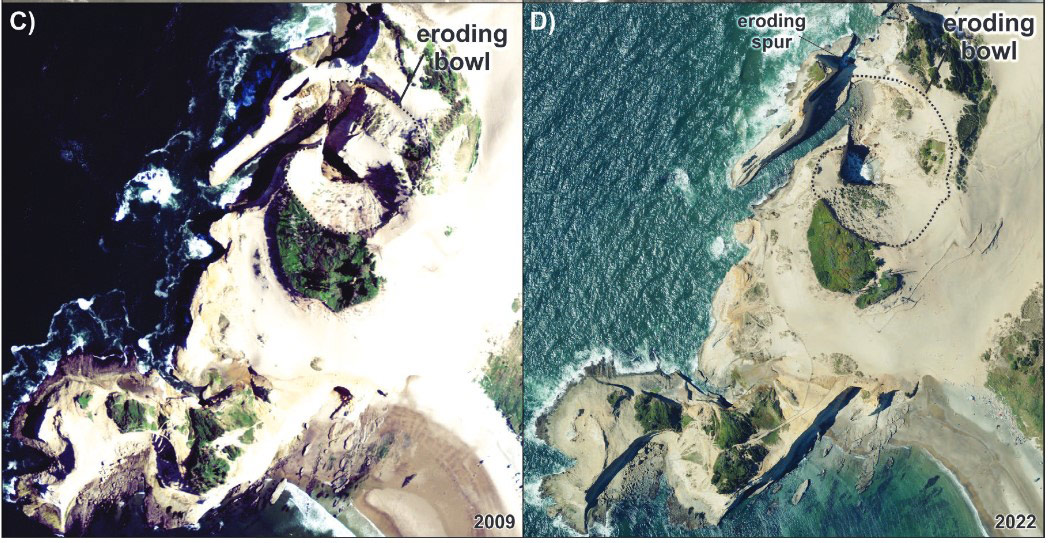
Photos from the study: at left, 2009. At right, present day (Allan)
It's going to look more like the myriad of "sky islands" to the west you now see.
Includes exclusive listings; some specials in winter
In Cannon Beach:
Includes rentals not listed anywhere else
In Manzanita, Wheeler, Rockaway Beach:
Some specials for winter
In Pacific City, Oceanside:
Some specials for winter
In Lincoln City:
Some specials for winter
In Depoe Bay, Gleneden Beach:
Some specials for winter
In Newport:
Look for some specials
In Waldport
Some specials for winter
In Yachats, Florence
Some specials for winter
Southern Oregon Coast Hotels / Lodgings
Reedsport to Brookings, places to stay; winter deals
How long this area has before it's truly unsafe is impossible to say, but Oregon coast geologists Laura Gabe and Jonathan Allan – authors of the study - recommended OPRD should be proactive here. Some 50 feet of the headland should be cordoned off.
There's a lot of things the study found, including sea caves, various rockslides and evidence of what kind of water erosion is taking place. Yet one thing is foremost: Cape Kiwanda truly is falling apart in places.
“The sinkholes ranged in width from ~4.5 to 10 m (15 to 33 ft), while the smaller sinkhole had an estimated depth of ~5 m (16 ft),” the study said.
See the beginning Cape Kiwanda's Sinkholes Merging, N. Oregon Coast Landmark a Little More Dangerous
Allan and Gabe said the larger sinkhole could not be measured for depth due to material that had fallen in.
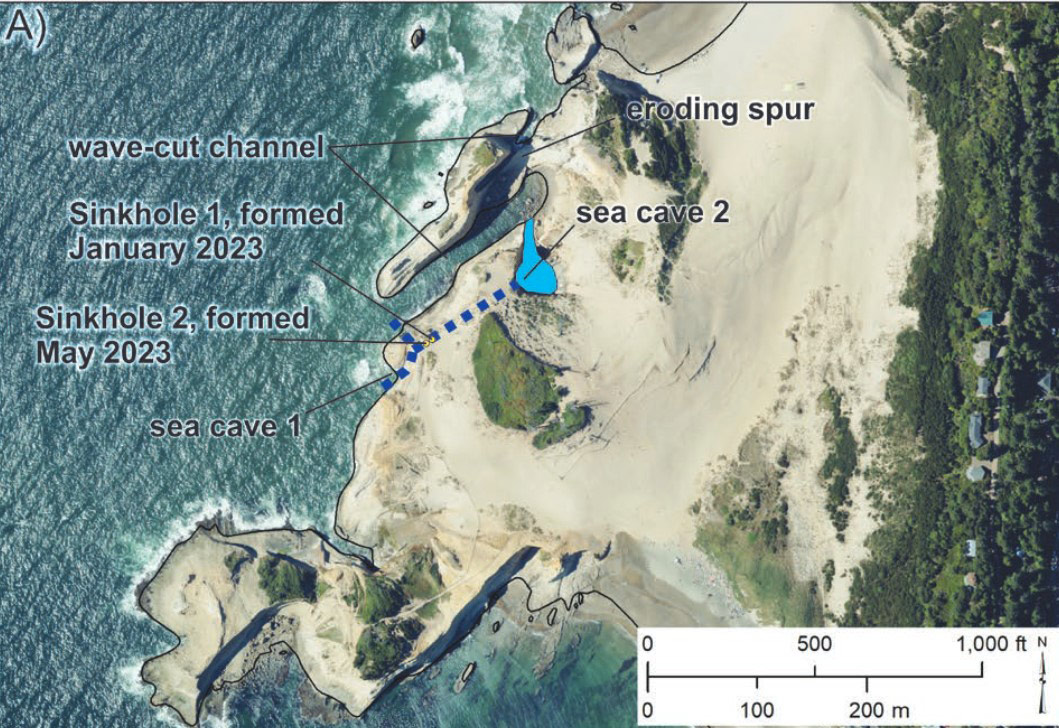
Courtesy Allan
They said they believed the sinkholes were likely formed from a weak spot in the rock of Kiwanda, which is part of the Astoria Formation – roughly 18 million years old.
What has been the working theory among many geologists is there were sea caves beneath the sinkholes, and that material simply gave way. That, according to the study, probably isn't the case, but rather they think water from above seeped in slowly created a void.
There are indeed two large sea caves which form a large cave system inside the Oregon coast landmark, but they don't connect to the sinkholes – at least the evidence doesn't point to that. This is because the surface of the sea cannot be seen from the sinkholes.
What's a bit remarkable is that part of why this happened is due to a unique composition of the rocks that makes them vulnerable to dissolving.
“The ability to form a void within the sandstone also implies some unique geologic characteristics about the chemical disposition of the sediments below the collapse sinkhole,” they wrote. “Hence, the formation of the sinkhole cannot be solely a function of a joint/fissure, but may also have resulted from chemical dissolution. A weakness in the underlying sediment, perhaps within its mineral structure, could have allowed water to preferentially dissolve the mineral, eventually leading to the formation of a void and its eventual collapse.”
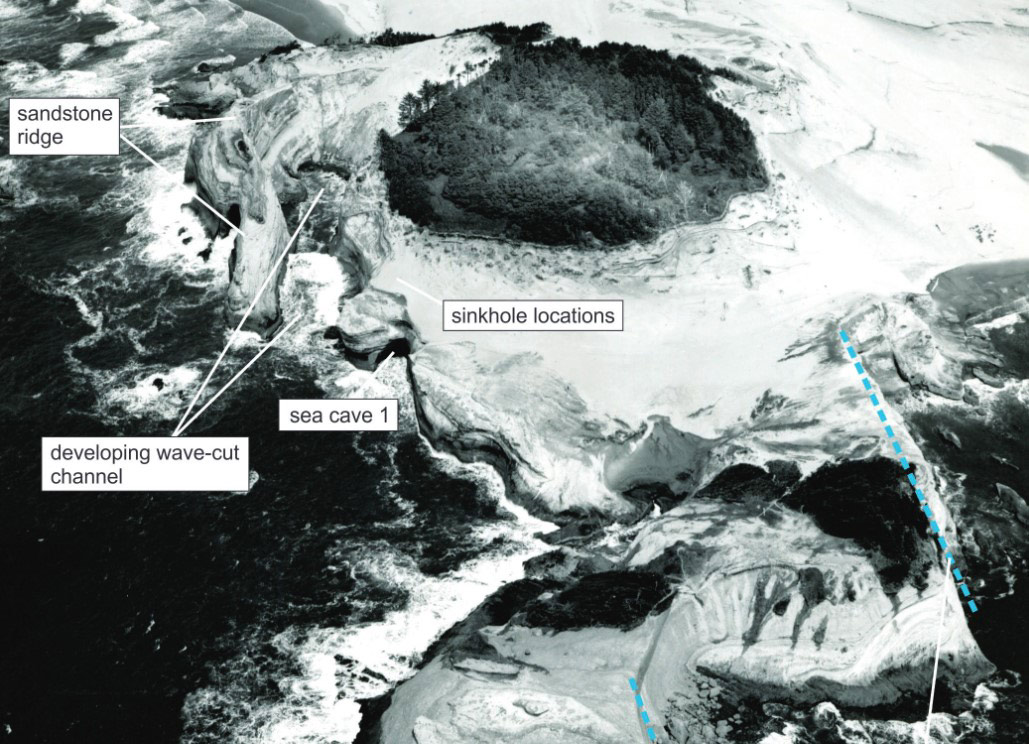
Kiwanda in '74 (compare this with the photos above)
Gabe and Allan collected numerous historical photos over the last 80 years and discovered quite a bit of erosion of the cape in various places. Waves are cutting new channels, sea caves are getting enlarged, and more rockslides are occurring around the cape. Then there's an area called “the bowl” at the northern end (not to be confused with the “bowl” at the southwest end that was cordoned off two years ago), which the pair strongly recommend fencing off.
“Due to the rapid speed in which this part of Cape Kiwanda is presently eroding and the presence of a large cave system at sea level directly below the sinkholes, we recommend that Oregon State Parks and Recreation Department establish a new fence line approximately 15 m (50 ft) south of the two sinkholes.”
Perhaps most remarkable is the future of Cape Kiwanda, which looks to be more chopped up into separate “islands” than most have imagined.
Also see Cape Kiwanda Almost Had Nuclear Power Plant: Bizarre Oregon Coast State Park History
“In time, we suspect that this part of Cape Kiwanda may eventually form a small sea stack as the western sea cave collapses, while a wave-cut channel could eventually form along the main east-west cave system, similar to the existing wave-cut channel located immediately north of the developing cave system.”
Fencing along Cape Kiwanda was just redone two years ago, allowing for the public to better get pictures of some of the more popular features while still remaining safe. OPRD found people were hopping the fences too close to areas which were definitely unstable or prone to tidal dangers. Now, those lines have to be redrawn.
Other Interesting Takeaways from the Study
- Sand has been blowing onto Cape Kiwanda for 2.6 million years.
- Cape Kiwanda once extended much farther out and it and Haystack Rock were once connected.
- Allan and Gabe have not entirely given up on the idea that the cave system extends below the sinkholes; they're hoping to study that more. This could also enable them to predict other areas that might cave in.
- The power of the waves is not entirely ruled out, but there is currently more evidence towards the chemical processes of dissolution.
“Finally, we cannot rule out entirely mechanical action from the waves below, though this seems highly unlikely when compared with dissolution weathering of the rock strata,” they wrote.
- The “bowl” also presents new dangers:
“Finally, our fieldwork within the erosion 'bowl' indicated the presence of active slope instabilities. We recommend building a new fence line in the northeast to keep people out of the erosion bowl as this part of the Cape remains unstable, while maintaining a view overlooking the area.”
Hotels in Three Capes - Where to eat - Three Capes Maps and Virtual Tours
Cannon Beach Lodging
Nehalem Bay Lodgings
Manzanita Hotels, Lodging
Three Capes Lodging
Pacific City Hotels, Lodging
Lincoln City Lodging
Depoe Bay Lodging
Newport Lodging
Waldport Lodging
Yachats Lodging
Oregon Coast Vacation Rentals
Oregon Coast Lodging Specials
More About Oregon Coast hotels, lodging.....
More About Oregon Coast Restaurants, Dining.....
 Andre' GW Hagestedt is editor, owner and primary photographer / videographer of Oregon Coast Beach Connection, an online publication that sees over 1 million pageviews per month. He is also author of several books about the coast.
Andre' GW Hagestedt is editor, owner and primary photographer / videographer of Oregon Coast Beach Connection, an online publication that sees over 1 million pageviews per month. He is also author of several books about the coast.
LATEST Related Oregon Coast Articles
Quakes on Dec. 15, 17, 20 and last night off Coos Bay, Bandon. Geology
Kiwanda Coastal Properties - Pacific City Hotel Reviews
Rates rock bottom now, but for an extra 10 perc use code 'BEACHCONNECT'. Click to see
Mussel Gathering Closed Again on S. Oregon Coast After Biotoxins Found
Paralytic shellfish toxin found Cape Blanco to Brookings. Marine sciences
This Week's Storms Could Reveal Oregon Coast Oddities: More Ghost Forests, 'R...
A geologic freak zone may open up - but maybe agates, too
Historical Timeline of South Oregon Coast Landmark: Port Orford Lifeboat Stat...
Also: Hugh House back open for tours at Cape Blanco. South coast events
The Difference Between Short Beach and Short Sands Beach at N. Oregon Coast's...
Short Beach near Oceanside and Short Sand Beach near Manzanita. Cannon Beach, Arch Cape, Tillamook, Garibaldi
Understanding the Oregon Coast Under Our Feet: Lincoln City Talk Given by Pro...
Oct 17 in Lincoln City, Oregon geologist Scott Burns. Lincoln City events
Waves That Go the Wrong Direction: Here's Why It Happens on Oregon's Coast (V...
A curious twist of beach physics and geology. Sciences, weather
Back to Oregon Coast
Contact Advertise on Oregon Coast Beach Connection
All Content, unless otherwise attributed, copyright Oregon Coast Beach Connection. Unauthorized use or publication is not permitted



















































